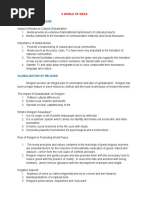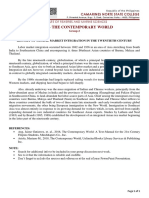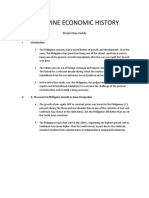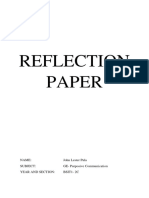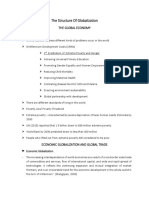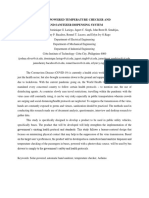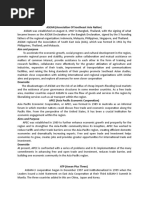0 ratings0% found this document useful (0 votes)
308 viewsGlobal City GEC 106
Global City GEC 106
Uploaded by
John Ferdie MadulidBrain drain refers to the migration of skilled workers from developing to developed countries. Brain gain refers to migrants who return home with new skills and knowledge that can benefit their home country's development. Brain waste refers to situations where migrants work in jobs that do not match their skill levels.
Copyright:
© All Rights Reserved
Available Formats
Download as PPTX, PDF, TXT or read online from Scribd
Global City GEC 106
Global City GEC 106
Uploaded by
John Ferdie Madulid0 ratings0% found this document useful (0 votes)
308 views32 pagesBrain drain refers to the migration of skilled workers from developing to developed countries. Brain gain refers to migrants who return home with new skills and knowledge that can benefit their home country's development. Brain waste refers to situations where migrants work in jobs that do not match their skill levels.
Original Description:
Global city
Original Title
global city GEC 106
Copyright
© © All Rights Reserved
Available Formats
PPTX, PDF, TXT or read online from Scribd
Share this document
Did you find this document useful?
Is this content inappropriate?
Brain drain refers to the migration of skilled workers from developing to developed countries. Brain gain refers to migrants who return home with new skills and knowledge that can benefit their home country's development. Brain waste refers to situations where migrants work in jobs that do not match their skill levels.
Copyright:
© All Rights Reserved
Available Formats
Download as PPTX, PDF, TXT or read online from Scribd
Download as pptx, pdf, or txt
0 ratings0% found this document useful (0 votes)
308 views32 pagesGlobal City GEC 106
Global City GEC 106
Uploaded by
John Ferdie MadulidBrain drain refers to the migration of skilled workers from developing to developed countries. Brain gain refers to migrants who return home with new skills and knowledge that can benefit their home country's development. Brain waste refers to situations where migrants work in jobs that do not match their skill levels.
Copyright:
© All Rights Reserved
Available Formats
Download as PPTX, PDF, TXT or read online from Scribd
Download as pptx, pdf, or txt
You are on page 1of 32
BRAIN DRAIN - refers to the large outflows of educated and skilled labor
migrants, especially those originating from developing countries and
moving towards developed or highly industrialized countries. In more
specific terms, it refers to the “international transfer of resources in the form
of human capital, i.e., the migration of relatively highly educated
individuals from developing to developed countries” (Beine, Docquier and
Rapoport, 2003).
BRAIN GAIN - refers to migrants who return home with accumulated
knowledge, expertise and skills, advanced technology and economic and
social capital, all of which are deemed potential contributions to the
development and growth of the country of origin (Wickramasekara, 2003).
Brain Waste - refers to situations in which migrants take on jobs that do not
correspond to their skills sets (Mattoo, Neagu and Özden, 2008, cited in
Docquier and Rapoport, 2011).
The GLOBAL CITY
Facilitator: Voltaire B. Jacinto
QUESTIONS????
What are global cities?
What are the attributes of a global city?
Why globalization is a spatial phenomenon?
How cities served as engines of globalization?
What are GLOBAL CITIES?
Defining the Global City
New global cities have since arisen not only as
financial centers but also a producers of
services that are global in scope
Global cities are post-industrial
Manufacturing has been scattered across
national and global networks
Turn from “landscapes of production” to
“landscapes of consumption”
Defining the Global City
Global cities are “brain hubs” and centers of a
“knowledge economy”
Economies of scale and concentration are necessary
despite the proliferation of communications technology
Network economies and spillover effects include “thick
labor markets” in knowledge workers.
Polarization extends to differentiation by human capital
(skills and formal education)
Global City?
Sociologist Saskia Sassen popularized this
term.
Her The Global City: New York, London, Tokyo
(1990) has shaped the concepts and
methods used to analyze the role of cities
and their networks in the contemporary
world.
Sassen’s concept of Global City gives
emphasis on the flow of information and
capital.
Global Cities are major nodes in the
interconnected systems of information and
money, and the wealth that they capture is
intimately related to the specialized
businesses that facilitate those flows.
making sense of urban systems and their
global networks
In the age of globalization, the
activities of production are
scattered on a global basis.
These complex, globalized production networks require new
forms of financial and producer services to manage them.
WHY STUDY GLOBAL CITIES?
Globalization as Spatial Phenomenon
Spatial as it occurs in physical spaces.
- Foreign investments and capital move through a city
- Companies build skyscrapers
Globalization is spatial because what makes it move is the fact that it is
based in places. In other words, cities act on globalization and
globalization acts on cities:
-Los Angeles, home of Hollywood, is where movies are made for
global consumption
-Tokyo, headquarters of Sony, the company coordinates the sale
of its various electronics goods to branches around the globe
Attributes of Global City
SEATS OF ECONOMIC POWER
New York have the largest stock market in the world
Tokyo houses the most number of corporate headquarters
Shanghai plays critical role in the global economic supply
CENTERS OF AUTHORITY
Washington DC, not wealthy as New York, but it’s the seat of American Power
Canberra is Australia political capital: home to country’s politicians and
bureaucrats
CENTERS OF POLITICAL INFLUENCE
Cities that house major International Organizations: UN-New York, EU-Brussels
CENTERS OF HIGHER LEARNING AND CULTURE
The question then becomes how to
identify these cities, and perhaps to
determine to what extent they
function as global cities specifically,
beyond all of the other things that
they do simply as cities.
1. AT Kearney’s list, developed in conjunction with
the Chicago Council on Global Affairs. Global Cities
Index uses criteria across five dimensions:
A. Business Activity (headquarters, services firms,
capital markets value, number of international
conferences, value of goods through ports and
airports)
B. Human Capital (size of foreign born population,
quality of universities, number of international
schools, international student population, number of
residents with college degrees)
C. Information Exchange (accessibility of major TV news
channels, Internet presence (basically number of
search hits), number of international news bureaus,
censorship, and broadband subscriber rate)
D. Cultural Experience (number of sporting event,
museums, performing arts venues, culinary
establishments, international visitors, and sister city
relationships).
E. Political Engagement (number of embassies and
consulates, think tanks, international organizations,
political conferences)
2. The Institute for Urban Strategies at The Mori Memorial Foundation
in Tokyo published another study called “The Global Power City
Index 2011.” This report examined cities in terms of functions
demanded by several “actor” types: Manager, Researcher, Artist,
Visitor, and Resident.
The functional areas were:
A. Economy (Market Attractiveness, Economic Vitality,
Business Environment, Regulations and Risk)
2. Research and Development (Research Background,
Readiness for Accepting and Supporting Researchers,
Research Achievement)
3. Cultural Interaction (Trendsetting Potential,
Accommodation Environment, Resources of Attracting
Visitors, Dining and Shopping, Volume of Interaction)
4. Livability (Working Environment, Cost of Living, Security
and Safety, Life Support Functions)
5. Environment (Ecology, Pollution, Natural Environment)
6. Accessibility (International Transportation Infrastructure,
Inner City Transportation Infrastructure)
Mori Foundation Global City Power Index (2015)
Global Power City top 10: (2016)
1. London,
2. New York City,
3. Tokyo,
4. Paris,
5. Singapore,
6. Seoul,
7. Amsterdam,
8. Berlin,
9. Hong Kong,
10. Sydney.
3. Another popular ranking is the Economist Intelligence Unit’s
Global City Competitiveness Index. They rank cities on a number of
domains:
A. Economic Strength (Nominal GDP, per capita GDP, % of
households with economic consumption > $14,000/yr, real
GDP growth rate, regional market integration)
B. Human Capital (population growth, working age
population, entrepreneurship and risk taking mindset,
quality of education, quality of healthcare, hiring of
foreign nationals)
C. Institutional Effectiveness (electoral process and
pluralism, local government fiscal autonomy, taxation, rule
of law, government effectiveness)
D. Financial Maturity (breadth and depth of financial cluster)
E. Global Appeal (Fortune 500 companies, frequency of international
flights, international conferences and conventions, leadership in higher
education, renowned think tanks)
F. Physical Capital (physical infrastructure quality, public transport
quality, telecom quality)
G. Environment and Natural Hazards (risk of natural disaster,
environmental governance)
H. Social and Cultural Character (freedom of expression and human
rights, openness and diversity, crime, cultural vibrancy)
4. Jon Beaverstock, Richard G. Smith and Peter J. Taylor
established the Globalization and World Cities Research Network
(GaWC). A roster of world cities in the GaWC Research Bulletin 5 is
ranked by their connectivity through four "advanced producer
services": accountancy, advertising, banking/finance, and law
Alpha world cities (with four sub-categories),
Alpha ++, alpha +, alpha, alpha-
Beta world cities (three sub-categories),
Beta +, Beta, Beta-
Gamma world cities (three sub-categories) and additional cities
with High sufficiency or Sufficiency presence.
Gamma+, Gamma, Gamma-
Suggested activities:
1. Look (Google) for these global cities according to
any of the four ranking/research groups. Compare
the ranking, criteria, and sustainability factors.
Analyze how globalization contributed to their
success
2. Present a video-tour of these cities (Youtube will
help you) to amaze our students. Critique and
process.
3.
CHALLENGES OF GLOBAL CITY
GLOBAL CITIES CAN BE SITES OF GREAT INEQUALITY AND POVERTY
New York and Tokyo can be sustainable because of their density: denser
settlements yield energy savings; extensive public transportation systems enable
people to drive less cutting carbon emission
Los Angeles meanwhile are urban sprawls, with massive freeways that force
residents to spend money on cars and gas
Manila, Bangkok, and Mumbai are dense, their lack of public transportation and
the government’s inability to regulate car Industries have made them extremely
polluted
TREMENDOUS VIOLENCE CAUSE BY TERROR ATTACKS
9/11 attack in New York in 2001
Attacks by Zealots of the Islamic State of Iraq and Levant in
Paris
THE GLOBAL CITY AND THE POOR
MASSIVE INEQUALITY SITED IN SOME MAJOR CITIES
Cities like Mumbai, Manila and Jakarta have gleaming building
alongside massive shanty towns
GENTRIFICATION is a phenomenon of driving out the poor
in favor of newer, wealthier residents
African-Americans and Immigrants in New York and San
Francisco are being forced to move farther away from the
economic centers of their cities
BANLIEUE
A cluster of ethnic enclaves which includes poor Muslim migrants
forced to be out of Paris
CONCLUSION
Global Cities are material representation of Globalization
They are places that create the exciting fusion of culture
and ideas which also generate tremendous wealth
Yet, they remain sites of great inequality, where global
servants serve global entrepreneurs
The question of how globalization can be made more just
is partly a question of how people make their cities more
just
Talking Points:
1. While most of us will not be living in global cities,
how will our lives be affected by them?
2. Are the contradictions and polarizations in the
global city inevitable?
3. In what sense are cities mediums of globalization?
4. Why is economic power the most crucial
determinant of a global city?
5. Why is there a lot of inequality in global cities?
Suggested activities:
1. Identify other challenges and threats on global cities.
How these threats were managed?
2. City Selection: Divide class into ten groups. Each group
will feature one of the top ten global cities. Present and
critique in class. Creativity and visual presentation is
necessary.
3. My Global City :
1. Write a petition/position letter to the LGU (City Council) what you
want you city to have in future as a global city. (35pts.)
A. Cite facilities and infrastructure necessary
B. How to manage the challenges and threats to human condition?
C. what would make you city unique?
(How would you enhance/integrate local and national heritage into
your global city. )
Note: variant activities exploring the same topic would be more
appropriate.
THANK YOU VERY MUCH.
You might also like
- Cambridge - Science - WB6Document96 pagesCambridge - Science - WB6Long Nguyễn Hoàng94% (16)
- Project Report On A CA FirmDocument53 pagesProject Report On A CA FirmAshita Rastogi47% (34)
- Educational PlanningDocument32 pagesEducational Planningtandangmark93% (45)
- Committee and Meetings (Infection Control)Document3 pagesCommittee and Meetings (Infection Control)Lua CJ100% (5)
- TCW Asian RegionalismDocument28 pagesTCW Asian RegionalismAgnesMagadia67% (6)
- Global Communication. Chapter 10. Denis McQuail.Document11 pagesGlobal Communication. Chapter 10. Denis McQuail.ElenakhileshNo ratings yet
- Flight ManualDocument161 pagesFlight ManualJames EthridgeNo ratings yet
- January 2022 Edexcel Awards FinalDocument6 pagesJanuary 2022 Edexcel Awards Finalwissam riyas0% (1)
- Language: UNIT 1: Language and Skills TestDocument3 pagesLanguage: UNIT 1: Language and Skills TestLjiljana Maksimovic50% (2)
- Global City 1Document34 pagesGlobal City 1regane villorejoNo ratings yet
- Global CityDocument6 pagesGlobal CityWena PurayNo ratings yet
- Lesson 8 - Global CityDocument5 pagesLesson 8 - Global CityELLE GONZALESNo ratings yet
- Global City 1Document30 pagesGlobal City 1Dean ivan ParalesNo ratings yet
- Global City FinalDocument19 pagesGlobal City FinalPaul Erwin AustriaNo ratings yet
- W8 Global City - ModuleDocument7 pagesW8 Global City - ModuleEdgardo LasernaNo ratings yet
- Contemporary World: (GE 3) Final ModuleDocument17 pagesContemporary World: (GE 3) Final ModuleAbegail BlancoNo ratings yet
- World Population: Global Population and Mobility (Handouts)Document7 pagesWorld Population: Global Population and Mobility (Handouts)Carl Lanuzga100% (1)
- What Are The Components of A Compensation SystemDocument5 pagesWhat Are The Components of A Compensation SystemLing Ching YapNo ratings yet
- Economic Situation/ Development of Global DivideDocument2 pagesEconomic Situation/ Development of Global DivideLyka Casapao AgultoNo ratings yet
- What Is GlobalizationDocument11 pagesWhat Is GlobalizationProsenjit100% (4)
- The Global CityDocument6 pagesThe Global CityErica Grace SanchezNo ratings yet
- Process QuestionsDocument10 pagesProcess QuestionsCrash Override0% (1)
- A World of Ideas Global Media CulturesDocument10 pagesA World of Ideas Global Media CulturesKayeNo ratings yet
- Global Media CulturesDocument34 pagesGlobal Media CulturesCatherine Fetizanan100% (1)
- Handouts Contemporary PDFDocument5 pagesHandouts Contemporary PDFNelzen GarayNo ratings yet
- Global City Lesson 3Document27 pagesGlobal City Lesson 3alex100% (2)
- Activity 3 - Reflection of The Structures of GlobalizationDocument2 pagesActivity 3 - Reflection of The Structures of GlobalizationPaul Zachary A. DandanNo ratings yet
- Planning NSTPDocument15 pagesPlanning NSTPErl DrizNo ratings yet
- Global Media Culture: A World of IdeasDocument4 pagesGlobal Media Culture: A World of IdeasSherelyn RoblesNo ratings yet
- Reviewer in Contemporary WorldDocument43 pagesReviewer in Contemporary WorldEloiza PachecoNo ratings yet
- Rizal's Parisian LifeDocument45 pagesRizal's Parisian LifeJERIA PAULA DELIMANo ratings yet
- World Heritage Sites in The PhilippinesDocument3 pagesWorld Heritage Sites in The PhilippinesSharmane SantiagoNo ratings yet
- TCWD Week 9 - Globalization and Media LectureDocument6 pagesTCWD Week 9 - Globalization and Media Lecturelol mobile wild riftNo ratings yet
- Hotel Rwanda Movie ReflectionDocument2 pagesHotel Rwanda Movie ReflectionJazzy MercadoNo ratings yet
- Group 2 History of Global Market IntegrationDocument1 pageGroup 2 History of Global Market Integrationstephanie canapitNo ratings yet
- Lesson 6 - Global Media and ReligionDocument90 pagesLesson 6 - Global Media and ReligionSandeepNo ratings yet
- Global CitizenshipDocument3 pagesGlobal CitizenshipMaire NaragNo ratings yet
- ACTIVITIES The Contemporary WorldDocument1 pageACTIVITIES The Contemporary WorldAnnalyn EndrinalNo ratings yet
- TCW Module 3 Pre FinalDocument20 pagesTCW Module 3 Pre FinalMark Jade BurlatNo ratings yet
- The Contemporary World: Lesson 1Document1 pageThe Contemporary World: Lesson 1Angelo Jude Cobacha50% (2)
- Chapter One: 1.1 Background of The StudyDocument14 pagesChapter One: 1.1 Background of The Studypercepshan100% (1)
- 04 Readings 1 Discussion - RPHDocument1 page04 Readings 1 Discussion - RPHCherry Ann Grace Flores100% (1)
- Supply and Demand of Tourism IndustryDocument14 pagesSupply and Demand of Tourism IndustrySHIREEN IFTKHAR AHMED-DMNo ratings yet
- Lesson 6 MacroDocument4 pagesLesson 6 MacroKikoTVNo ratings yet
- TCW Midterms Notes and LEDocument17 pagesTCW Midterms Notes and LEAngel HannahNo ratings yet
- Prepared By: Izabelle Joy A. Algar, LPTDocument21 pagesPrepared By: Izabelle Joy A. Algar, LPTArianne Rose FangonNo ratings yet
- Philippine Economic HistoryDocument6 pagesPhilippine Economic HistoryKristel FieldsNo ratings yet
- Global City 1Document22 pagesGlobal City 1Elvin ManjaresNo ratings yet
- GlobalizationDocument23 pagesGlobalizationSadia SaeedNo ratings yet
- 1 Introduction To GlobalizationDocument5 pages1 Introduction To GlobalizationReynalin Kae Adrias VelascoNo ratings yet
- Reflection PaperDocument9 pagesReflection PaperMarie AntoinetteNo ratings yet
- WP 8Document19 pagesWP 8Tyndall Centre for Climate Change Research50% (2)
- Trade Policies in The PhilippinesDocument2 pagesTrade Policies in The PhilippinesJo sueNo ratings yet
- Contempory Global GovernaceDocument36 pagesContempory Global GovernaceRodlan DiponNo ratings yet
- Global Economy and Market IntegrationDocument6 pagesGlobal Economy and Market IntegrationJoy SanatnderNo ratings yet
- Global Population and MobilityDocument7 pagesGlobal Population and MobilityAriel QuintanaNo ratings yet
- Introduction To GlobalizationDocument40 pagesIntroduction To GlobalizationDarlene Dacanay DavidNo ratings yet
- 8 Theories of Globalization - Explained!Document10 pages8 Theories of Globalization - Explained!Misis Scropi KokoNo ratings yet
- Global CitizenshipDocument4 pagesGlobal CitizenshipMichelle SabitNo ratings yet
- RA 1992 7607 - Magna Carta of Small Farmers PDFDocument18 pagesRA 1992 7607 - Magna Carta of Small Farmers PDFrbmalasaNo ratings yet
- Contemporary WorldDocument3 pagesContemporary WorldDondee PalmaNo ratings yet
- Introduction To Cultural Studies-S4-ElHadariDocument8 pagesIntroduction To Cultural Studies-S4-ElHadariSimo SimoNo ratings yet
- 20212C1 MOR 49 12 FinalPaper OLIVERDocument68 pages20212C1 MOR 49 12 FinalPaper OLIVERJoshua OliverNo ratings yet
- International Strategic AlliancesDocument19 pagesInternational Strategic AlliancesAniket Chowdhury50% (2)
- Contemporary WorldDocument3 pagesContemporary WorldAnn Dela CruzNo ratings yet
- W3 - W4 The Global Economy - Module PDFDocument4 pagesW3 - W4 The Global Economy - Module PDFJeariel TolentinoNo ratings yet
- Global CityDocument34 pagesGlobal Citychat gazaNo ratings yet
- AEC 215 Prelim LessonsDocument54 pagesAEC 215 Prelim LessonsJohn Ferdie Madulid100% (1)
- AEC 213-Final LessonsDocument77 pagesAEC 213-Final LessonsJohn Ferdie MadulidNo ratings yet
- Dominicans: Work and ContributionsDocument10 pagesDominicans: Work and ContributionsJohn Ferdie MadulidNo ratings yet
- Group 2 AugustianianDocument21 pagesGroup 2 AugustianianJohn Ferdie MadulidNo ratings yet
- IRR of JPIA-SAC ChapterDocument3 pagesIRR of JPIA-SAC ChapterJohn Ferdie MadulidNo ratings yet
- UN Prgrams, Specialized Agencies, FundsDocument19 pagesUN Prgrams, Specialized Agencies, FundsJohn Ferdie MadulidNo ratings yet
- DLP-cot 3Document6 pagesDLP-cot 3Evangeline FajardoNo ratings yet
- Gadadhar Abhyudaya PrakalpaDocument2 pagesGadadhar Abhyudaya PrakalpaAGNo ratings yet
- Proposed Standards in History and Geography EducationDocument8 pagesProposed Standards in History and Geography EducationFroilan CelestialNo ratings yet
- Lean OutlineDocument2 pagesLean OutlineTee Hor ChangNo ratings yet
- Medak District ProfileDocument41 pagesMedak District Profilesareenck100% (1)
- Communicative Approach Language Teaching PDFDocument2 pagesCommunicative Approach Language Teaching PDFStaceyNo ratings yet
- Early Numeracy For Learning Delayed LearnersDocument1 pageEarly Numeracy For Learning Delayed LearnersReycil Mangyao PetalcorinNo ratings yet
- BOHOL CW Q2 Wk5Document6 pagesBOHOL CW Q2 Wk5Janice Fuerzas Balmera CuragNo ratings yet
- What Is Culture?: CARLA's DefinitionDocument2 pagesWhat Is Culture?: CARLA's DefinitionAkeem SolomonNo ratings yet
- Human Capital Management - LupinDocument4 pagesHuman Capital Management - LupinLAKSHMI BALAKRISHNAN MBA19-21No ratings yet
- Fluent With Friends Success GuideDocument4 pagesFluent With Friends Success GuideAnderson Ribeiro Coriolano100% (1)
- Leadership Crossword - Crossword Labs - AnswersDocument2 pagesLeadership Crossword - Crossword Labs - AnswersMahesh PuranamNo ratings yet
- Ra-113838 Professional Teacher - Elementary Masbate 3-2023Document88 pagesRa-113838 Professional Teacher - Elementary Masbate 3-2023Jessa Marie JardinNo ratings yet
- Soft Skills Unit V NotesDocument5 pagesSoft Skills Unit V Notesmokshith8624No ratings yet
- Ehf Result Report 2023Document4 pagesEhf Result Report 2023Viral DaftaryNo ratings yet
- Quiz Score Sheet TemplateDocument1 pageQuiz Score Sheet TemplateSales NouveauxNo ratings yet
- Elem Methods - Turkey FeathersDocument3 pagesElem Methods - Turkey Feathersapi-273426303No ratings yet
- Oath-Taking SpeechDocument4 pagesOath-Taking Speechjourney1177No ratings yet
- BRANDDocument4 pagesBRANDSakshat PuroNo ratings yet
- Relations and FunctionsDocument10 pagesRelations and FunctionsankitjatNo ratings yet
- Islamic EducationDocument18 pagesIslamic EducationAhmad Fawaid SjadziliNo ratings yet
- Primary Psychopedagogical ProjectDocument16 pagesPrimary Psychopedagogical ProjectScribdTranslationsNo ratings yet
- Title Page of Jig SawDocument6 pagesTitle Page of Jig SawJilly Arasu33% (3)




























